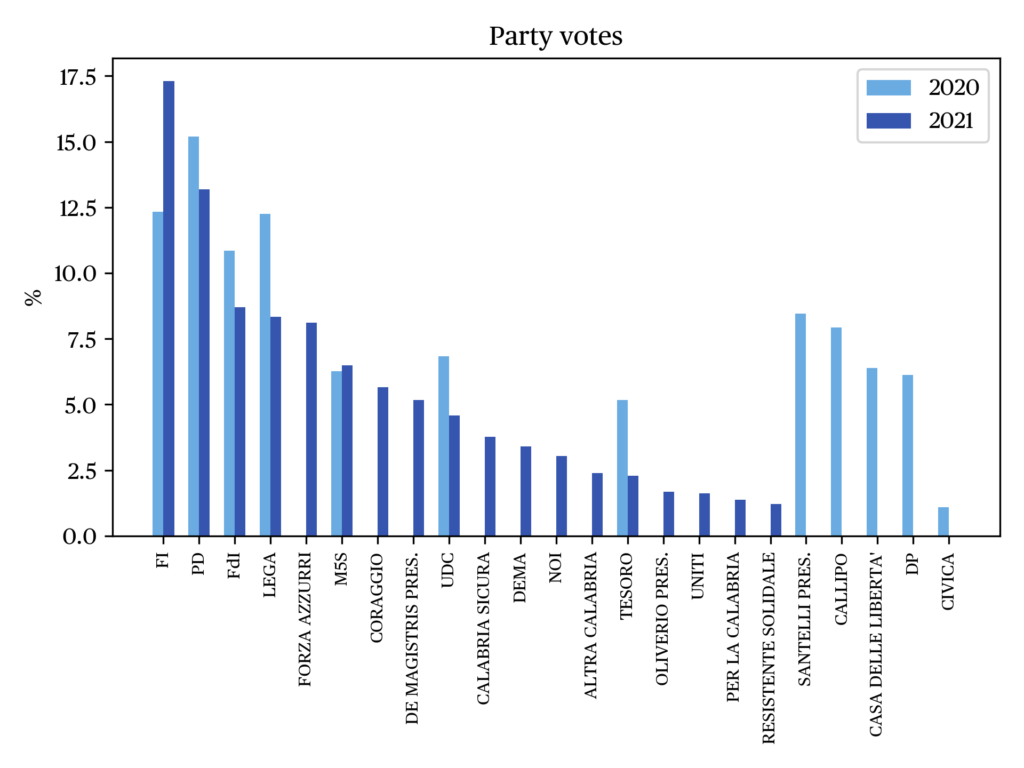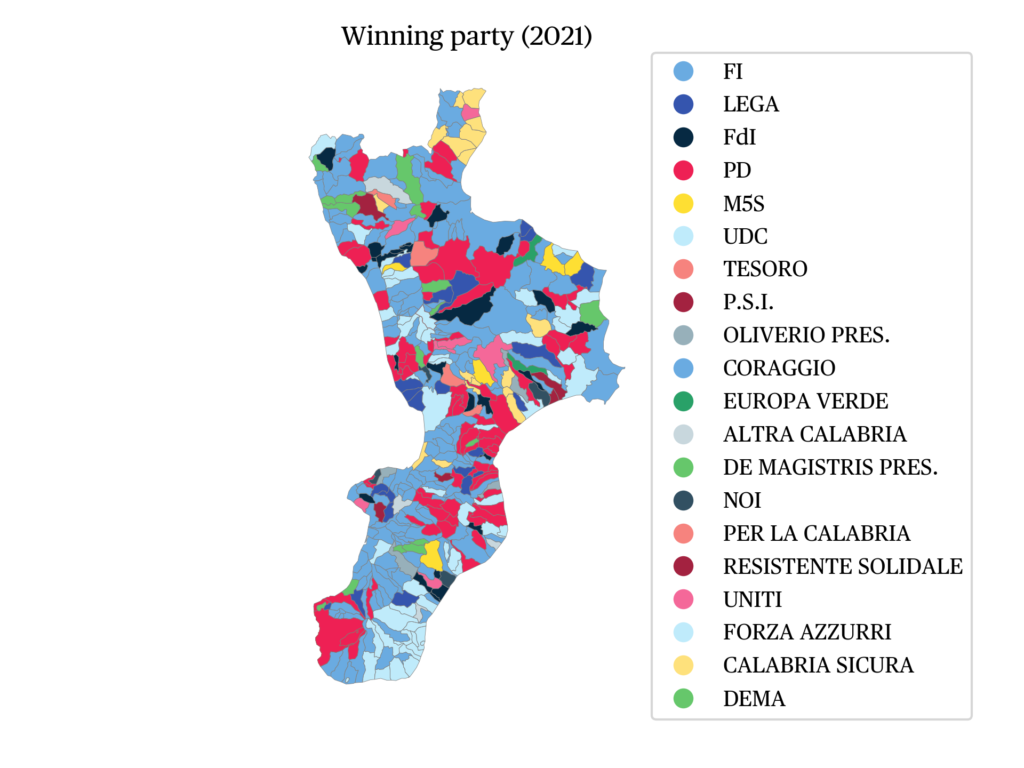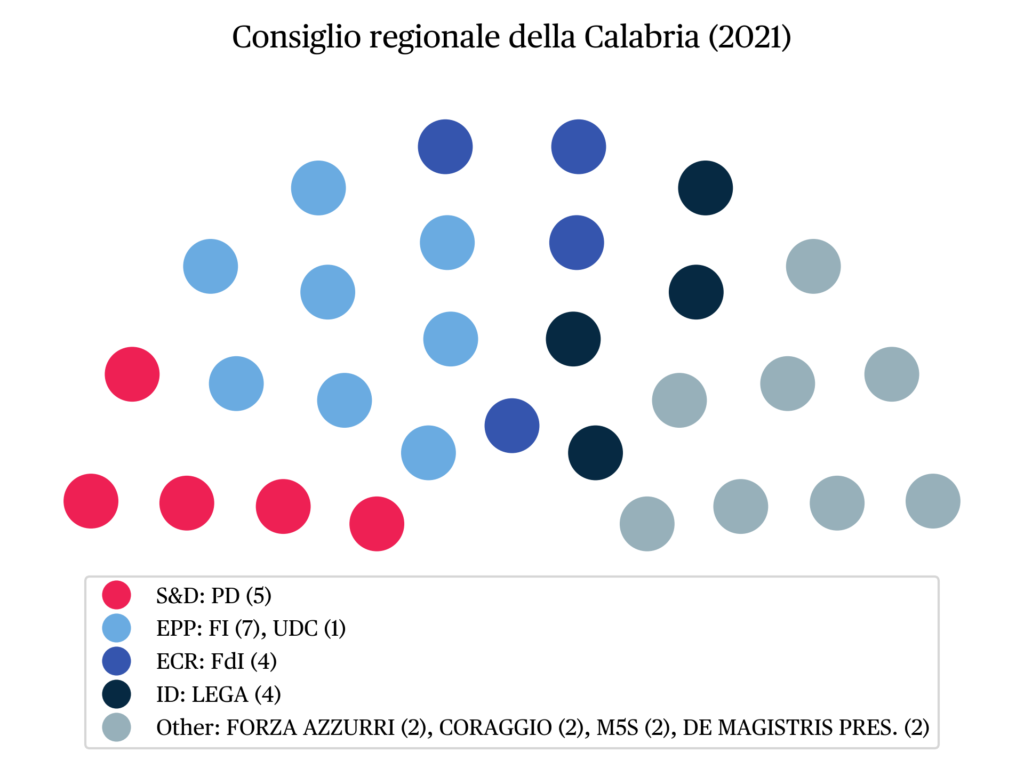Regional elections in Calabria, 3-4 October 2021
Francesco Giovanni Truglia
ISTAT researcherIssue
Issue #2Auteurs
Francesco Giovanni Truglia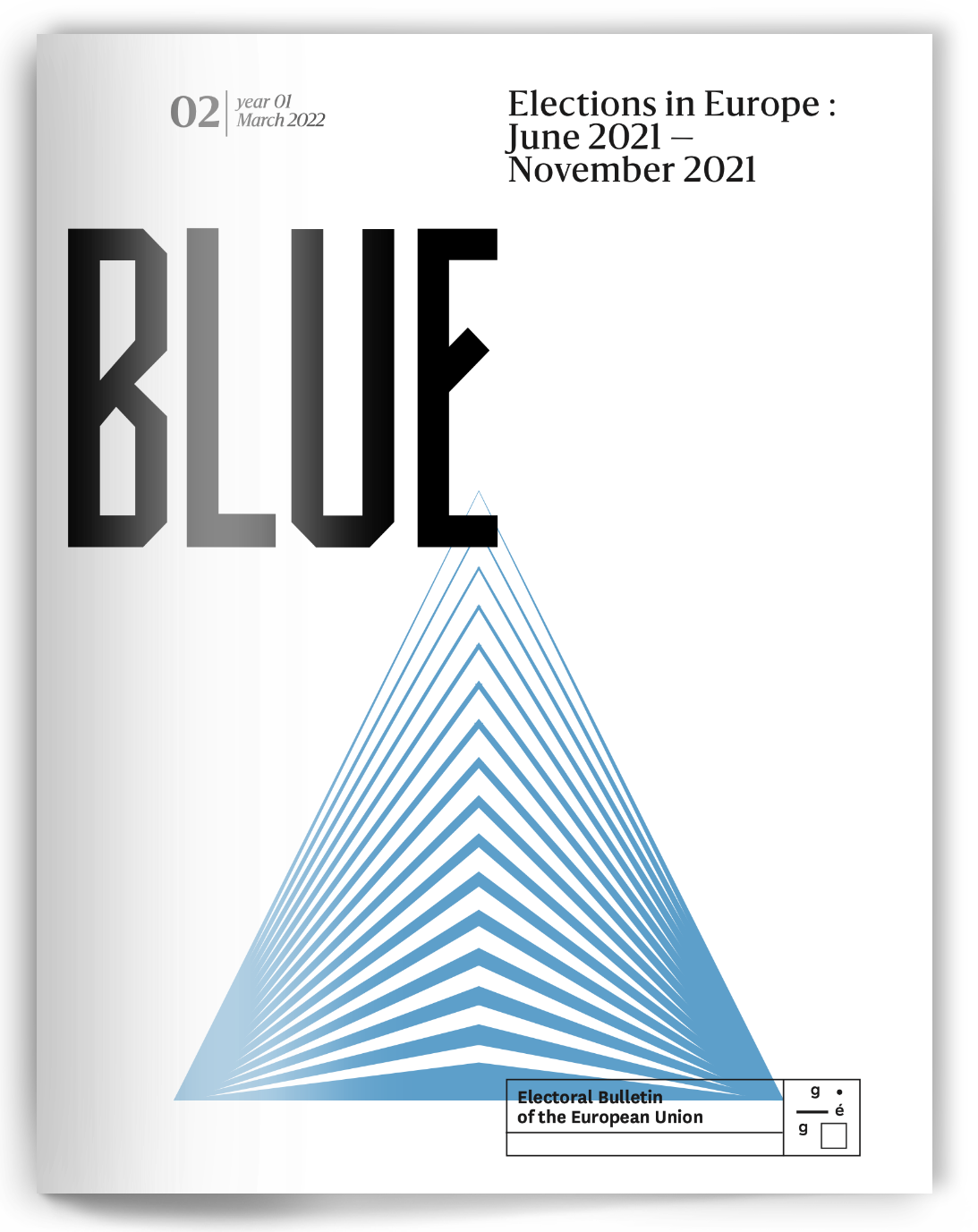
21x29,7cm - 167 pages Issue 2, March 2021 24,00€
Elections in Europe : June 2021 – November 2021
Introduction
In Mete (2020), referring to the regional elections of January 2020, but the same considerations can probably be extended to those of October 2021, speaks of the ‘political and media abandonment’ of Calabria, attributing this lack of interest not only to the ‘economic, political and demographic marginality’ of the region, but also to the predictability of the outcome of the elections, which, as another specialist in Calabrian facts, Roberto De Luca, points out, ‘are won before they take place’.
The predictability of the Calabrian people’s choices seems to respond, at least since the regional elections of 2000, to a kind of electoral determinism that decrees the defeat of the outgoing president.
It is still too early to say whether the reconfirmation of the centre-right at the head of the region in the October elections marks the beginning of the end of this rule, given the proximity in time of the previous elections and the circumstances that led to these new elections.
The mechanisms that trigger this change in power at the head of the region are not so much to be found in the dialectics that characterise party systems in democratic societies but, as a vast specialised literature now proves, in the proven capacity to move ‘packets’ of votes that are in the hands of a few ‘notables’
1
who, from one election to the next, can change sides according to their particular interests (De Luca 2015, Emanuele et Marino 2016).
This change in power without alternative in the management of public affairs, certified by economic, social and cultural indicators, blocks or, at best, hinders the development of the region and prevents the formation of a ruling class with solid political-administrative experience. No less serious, on the other hand, are the repercussions, in terms of disappointment and frustration, on the Calabrian population, which sees the commitments made by its own administrators at each electoral session evaporate (Mete 2020 : 30-31).
The change in power in the leadership of the region, and the instability and uncertainty of governmental action that ensues, are therefore not only attributable to the normal party dialectic, but also to the inability or unwillingness of the ruling class, both Calabrian and national, to cure a political-electoral system infected by the virus of the ‘notabilato.’ This is a system of domination and submission of public affairs to private interests, which is widespread throughout southern Italy, but which in Calabria seems to be particularly deep-rooted and effective, and which can be linked to the phenomenon, widely studied by sociology, of ‘familismo amorale’ (Cartocci 1985).
From a political point of view, the Calabrian issue seems to be fully in line with the cases of deinstitutionalisation of public life which, in this region, is not so much attributable to the birth-death of political parties (Sartori 1976, Casal Bértoa 2014), but rather to the temporary nature of the political position of the ‘notables’, whose weight in the electoral arena is also increased by the preference mechanism. In the case of Calabria, the consequences of deinstitutionalisation are therefore also aggravated by the effects of the mechanisms of the ‘candidate-based system’ (Fabrizio et Feltrin 2007).
These considerations and the literature cited therefore form the theoretical framework and provide an interpretative key for the analyses presented below, which are inserted in a medium-long term perspective (local elections 2010-2021) and highlight geo-electoral aspects using, for this purpose, some tools of Statistical Spatial Analysis.

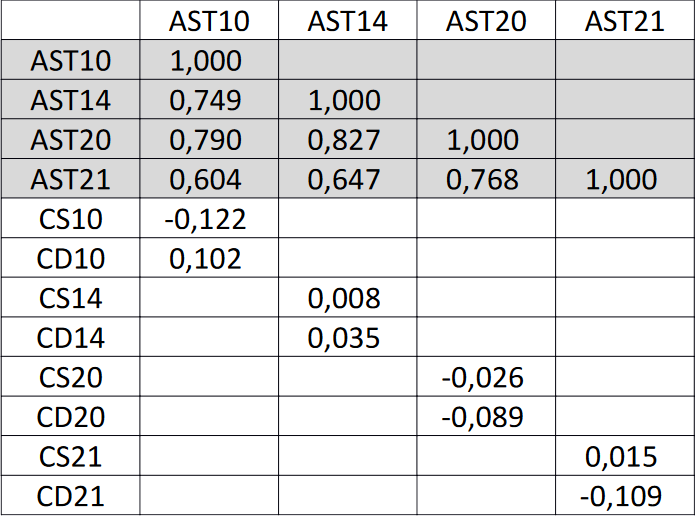
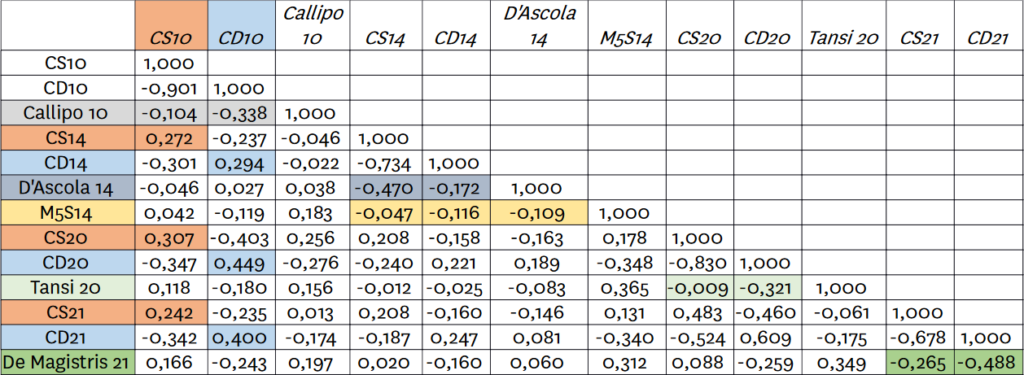
Voter demographics and abstentionism
On 3 and 4 October, after being postponed for a year due to the Covid-19 pandemic, early elections were held — following the untimely death of President Jole Santelli — for the renewal of the Council and the President of the Region.
Since 2010, this is the fourth time (a record that Calabria shares with Lazio) that Calabrians have gone to the polls to elect the region’s highest political-administrative institutions. In three of the four elections, the president of the region has been an expression of the centre-right and only in one, in 2014, of the centre-left. At least in the last decade, the orientation of the voters has favoured the CD. However, in order to assess the political significance of this result, some data on abstentionism, which is now an endemic phenomenon in Calabria (Truglia 2011), must be taken into account.
In the four elections under consideration, the number of Calabrians eligible to vote fluctuated around 1.88 million (Figure a), of which, in 2010, about 2 out of 5 did not go to the polls; this proportion increased considerably in the following elections until it exceeded half of the voters.
In relation to the demographic size of the municipalities, abstention is by far the highest in municipalities with less than 1,000 inhabitants. However, since 2014 there has been a general increase in this behaviour, with levels above 55% even in municipalities with at least 15,000 inhabitants, a sign that abstention is beginning to take root even in the most urbanised areas.
This phenomenon can be attributed to both demographic and political-electoral factors. With regard to the former, two aspects should certainly be highlighted. Firstly. Between 2010 and 2021, the Calabrian population decreased by more than 150 thousand people (-7.5%), but the most constant reduction (-116 thousand units) was recorded from 2014 and now amounts to -5.9%. The importance of these figures indicates that depopulation concerns both small and large municipalities (Natale, Santacroce et Truglia 2016). Furthermore, it must be taken into account that those who leave Calabria are mainly young people who, out of necessity or choice, decide to emigrate to other regions or abroad (ISTAT 2021: 156-157) and therefore often do not return to vote (Mete 2020: 32). The second aspect, linked to what has just been said, concerns the ageing of the population, which in Calabria between 2010 and 2021 increases from 42 to 45 years
2
, while the old age index increases from 130.2 to 169.5.
It is clear, however, that when abstentionists exceed 40%, it is no longer possible to attribute this behaviour to ‘laziness’ alone (Guelmini 2013, Tuorto 2006, Corbetta 1994), but it is also linked to political-cultural causes. These include, first of all, the inability of the political class to put an adequate and credible electoral offer on the table. In this case, the choice not to vote is motivated more by a specific political-electoral choice than by laziness (Truglia 2013). Moreover, if, as in the case of Calabria, there is also a temporal persistence of this behaviour, then it is possible to assume that it is a structured phenomenon (Truglia 2011), as is also evident from the results presented below.
The correlation index between abstention rates for the four electoral years (Figure b) is always positive and with values between 0.604 (years 2021/2010) and 0.827 (years 2020/2014). The temporal persistence of this phenomenon therefore seems to confirm that it is not just a question of Calabrians losing interest in the ballot box. In this sense, if we look at the correlations between the rates of abstentionism and consensus for the two coalitions, we can see how the values of this statistic are very low (only in 2010 and for the CD in 2021 it is slightly higher than 0.10), a sign that the political offer is not able to untie and channel into the electoral competition a substantial part of the Calabrian electorate. In all likelihood, therefore, what feeds this re-feeling, among a quota of Calabrian abstainers, could also be the distrust of a political class considered incapable of resolving or indicating a strategy to remedy problems that have been dragging on for decades and that are certified by the main socio-economic and cultural indicators. In this respect, it is interesting to note that during the decade under consideration, Calabria’s GDP per capita has remained almost stationary at around €28,000, the unemployment rate is 20.1% (+8.2% compared to 2010) and the female unemployment rate is 22.6% (+8.7% compared to 2010), while the number of young graduates (aged 30-34) is 20.7%. This figure places the region second to last, ahead of Puglia (19.8%) and Sicily (18.6%). In these two regions, young graduates have increased by 4% and 4.4% respectively compared to 2010, while in Calabria they have increased by only 1.6%.


Coalitions, parties and leaders
In the last elections, 424,666 voters voted for the CD, representing 55.7% of the total number of voters. Compared to 2010 and 2020, when this coalition won the regional elections, the CD lost about 1.8 and 1.4 percentage points. However, these two very similar percentages do not have the same meaning when translated into absolute values. In fact, in the first case, the CD loses about 20,000 voters and in the second 167,000 (about the entire population of the city of Reggio di Calabria).
The CS in 2020 stops at 27.4% of the vote, or a little over 200,000 voters, -1.8 percentage points compared to the previous year and well -7.4 points compared to 2010. But the real flight from the CS consensus, a real electoral landslide, occurs compared to 2014 with a drop of 34.7% or 273,808 voters.
As for the ‘third poles’, with the sole exception of the group led by De Magistris, which exceeded 15% of the votes, in all other elections these formations do not exceed 9% of the votes. This percentage, if considered solely from an algebraic point of view, cannot make up for the difference in votes between the winning coalition and the other; a difference that was 22% higher in 2010, 38% higher in 2014 and 27% higher in the last two elections (Figure e).
The presence of the ‘third pole’ undoubtedly has a political significance that goes beyond arithmetic, and can be understood both as an indicator of the ability of the national and local ruling class to mediate between different interests and demands, and as a sign of the activism of civil society, which thus continues to seek ways that are deemed more in line with regional needs than those proposed by traditional political forces.
Figure c shows the values of the correlation index for coalitions that obtained at least 3% of the vote; the ‘third poles’ are indicated, with the exception of the M5S, with the names of the candidates for the presidency of the region. A first consideration arises from the comparison between the different electoral years for the CD (in light blue) and the CS (in pink) and the low value recorded by this index between the 2010-2014, 2014-2020 and 2020-2021 votes, which for the CS oscillates between 0.242 and 0.307 and for the CD, a little higher, between 0.294 and 0.449. It would therefore seem that the latter electoral group is better able to ‘keep’ its electorate.
In 2021, the correlation between the votes for De Magistris and those for the CS and the CD is -0.265 and -0.488 respectively, so that in the municipalities where De Magistris is elected, support for the CS and, to a greater extent, the CD decreases. The values of the medium-high intensity correlation index indicate an increase in the level of competition between the coalition led by De Magistris and the other two coalitions, and in particular with the CS electorate, over which it most probably exerts a certain political-ideological attraction. Finally, it should be noted that the impact of De Magistris on the Calabrian electorate is evidenced by his personal success in obtaining 16.2% of the vote, i.e. + 1% more than the total votes obtained by the lists that supported him.
Among the various elements that differentiate the two camps, also in terms of evolution over time, we can certainly highlight the type of presidential candidate and the role played by the national parties within the two coalitions.
With regard to the first aspect, it seems that the evolution of this relationship between the two camps is different compared to 2010: in the last two rounds of elections, the CS seems to have relied more on the ‘personality’ of the presidential candidate, while the CD is stronger in terms of list votes. This consideration is also confirmed by the different ‘nature’ of the presidential candidates, who for the CS come from ‘politics’ (Scopelliti from the AN, Ferro, Santelli and Occhiuto from the PdL or the FI). For the CS, only Loiero and Oliverio are ‘party men,’ while in the last two elections Callipo and Bruni belonged to the so-called ‘civil society.’
Focusing on the electoral weight of the main political forces makes it possible to assess, in a way, the regional ‘vocation’ of these actors and therefore their propensity to take on specific problems and to find resources and solutions that do not always concern the region alone.
In the 2010-2021 electoral rounds, the Partito Democratico (PD) maintained a central position within the formation structured around this political topic. In contrast, the position of the Popolo delle Libertà (PdL) and Forza Italia (FI) within the CD seems less stable, and is, at least, threatened by the legitimate ambitions of the leaders of the Lega and Fratelli di Italia (FdI) to lead the CD at national level. One of the effects of the electoral dynamism of Salvini and Meloni is certainly the shift of the coalition’s centre of gravity to the right.
In the last elections, the PD led a coalition of seven parties and won more than 13% of the vote on its own, down 2 percentage points from 2020 and 10.6 points from 2014. However, despite this drop, the DP’s incidence in the CS remains very high, ranging from 38.4% in 2010 to 51.9% in 2020.
In 2020, Santelli leads a coalition of six parties, three of which are national in scope. In these elections, FI is joined by the League, which after Salvini’s ‘nationalist’ turn is no longer a party of the North (Passarelli et Tuorto 2018, Truglia 2018) and conquers 12.3% of the Calabrian electorate. The third party in the coalition is the FdI, which collects just over 10% of the vote.
The southward flight of the League and FdI suffered a setback in the last elections, not only because of the decline of FdI (-2.1%) and the League (-3.5%) and the simultaneous growth of FI (+5%), but also because the new president Occhiuto comes from the ranks of FI, a party of which he was the leader in the Chamber of Deputies, thus reaffirming its centrality within the CD.
Territorialisation of the electoral consensus
In the four electoral rounds, the number of municipalities won by one of the two coalitions has always exceeded 300. In 2014, the CS won the majority of votes in 394 of the 404 municipalities that make up the Calabrian territory (Figure d). This dynamic seems to be transversal both in relation to the provinces and to the demographic size of the municipalities. Suffice it to say that the 18 municipalities with a population of at least 15,000 seem to be united in favour or against a certain political formation.
It is now a question of taking a further step and trying to identify geo-electoral groups composed of municipalities that are similar in terms of consensus and contiguous in terms of geography.
This analytical approach has been widely used in various disciplinary fields and in studies where it is fundamental to assess contamination or spillover between units of analysis. In the field of electoral analysis, just to mention those concerning Italy, it is certainly worth mentioning the work of Agnew, some of which is mentioned in the bibliography.
From a statistical point of view, the indices referred to are those of spatial autocorrelation and, as far as this paper is concerned, the Gi* statistics of Getis and Ord (1992). Staying in the context of the Italian elections, this statistic is also used by Ignazi and Wellhofer in their study on the ‘Catholic vote’ (2017).
Before proceeding with the illustration of the results, it is worth giving some information about this statistic, which can be formalised as follows:

where :
- xj is the percentage of consensus of a political force in the j-th municipality;
- Mx and Sx are respectively the mean and the standard deviation of the variable xj;
- wij are the elements of an adjacency matrix W that are equal to 1 or 0 depending on whether two municipalities share a border section. 3
The scores of this index, suitably standardised, allow us to assess the statistical significance (p-value <0.05) of the distance between xi and Mx and to identify specific geo-electoral partitions, which are labelled as follows:
- Hot: high consensus municipalities contiguous to high consensus municipalities;
- Cold: low consensus municipalities contiguous to low consensus municipalities;
- Ns: municipalities with insignificant differences from the regional average.
The territorial configuration of the Calabrian electorate in the 2010 local elections, which in this work serves as a geo-electoral reference, is characterised by the presence of two large clusters of high electoral consensus which are located, for the CD, in the south and centre, and for the CS in the centre-north part of the region (Figure f).
The high intensity CD cluster is composed of 63 (16%) municipalities, most of them in the province of Reggio Calabria and, to a lesser extent, in the province of Catanzaro. More extensive, but with a lower number of municipalities (53), is the high consensus CS cluster that extends along the central-eastern part of the province of Cosenza. About ¼ of the support for CD and slightly less for CS comes from voters in these two clusters, which also include the cities of Reggio di Calabria (CD) and Cosenza (CS).

f) CG 2010 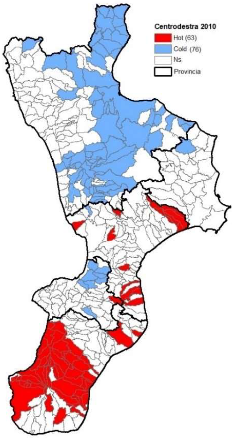
f) CD 2010 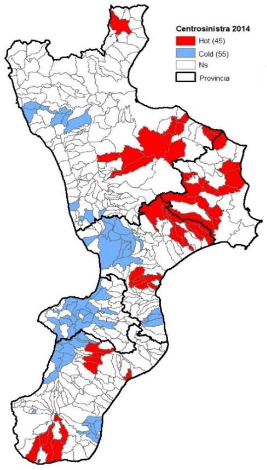
g) CG 2014 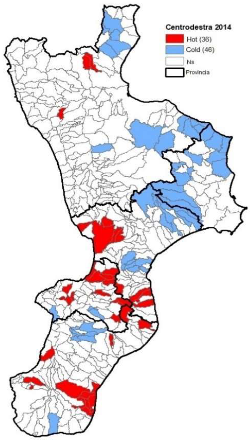
g) CD 2014

h) CG 2020 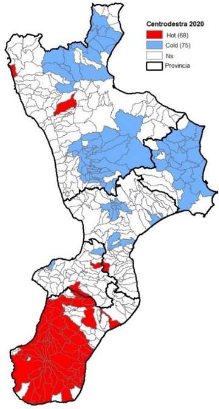
h) CD 2020 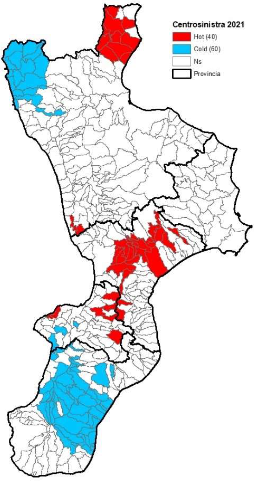
i) CG 2021 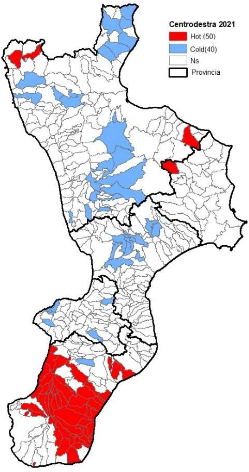
i) CD 2021
The most obvious fact in the 2014 electoral geography is the strong reduction — more important for CD, which dropped from 63 to 36 municipalities — of the two coalitions’ hot clusters and the consequent territorial fragmentation of their respective geo-electoral basins (Figure g).
The regaining of the leadership of the region by the CD in 2020 has two geo-electoral effects. The first is the formation of the high consensus cluster composed of 68 municipalities, of which only 5 are located outside the province of Reggio Calabria (Figure h). Compared to 2010, the cluster with low support for the CD has changed considerably, no longer extending only to municipalities in the province of Cosenza, but encompassing a large part of the Crotone region (Figure i). The second effect is the strong reshuffle and shift of the CS Hot cluster from the province of Cosenza to that of Catanzaro. In fact, the area of high CS consensus in the Cosenza area is reduced to a group of municipalities around Pollino. At the same time, in the province of Catanzaro, a new hot spot was created, comprising the same chief town and a group of municipalities extending along the hinterland of the Serre to the southern border of Vibo Valentia.
The electoral geography drawn by the ballot box in 2021 roughly confirms the spatial configuration of the hot zones of the two coalitions and, for the CS, also of the cold zones.
The most important changes with respect to 2020 are: i) the exit from the high consensus group of the city of Reggio di Calabria; ii) the reduction of the territorial coverage of this group from 68 to 50 municipalities; iii) the significant reduction of the low consensus group
Conclusion
Three political and electoral factors seem to have guided the choice of the Calabrian people between 2010 and 2021. The first is undoubtedly the greater capacity of the CD to present a unified candidacy capable of bringing together the different souls in this political space. The second, which is in some way linked to the first, concerns the personality of the candidate for the presidency of the Region, who, in the case of the CD, always comes from ‘politics’ rather than ‘civil society’ and is perhaps perceived, at least by those who go to the polls, as being more ‘equipped’ in political-administrative terms to lead the Region and more closely linked to national parties. The third element is the role of Berlusconi’s party which, despite the seats of Salvini and Meloni, remains fundamental both in terms of votes and geo-election. This role is confirmed by the fact that two of the three presidents of the CD come from the ranks of the FI.
The electoral geography of the years under consideration shows a constant spatial and temporal stability in the distribution of votes, which contrasts with the discontinuity of the majorities that have succeeded one another in leading the region. This contradiction is only apparent because these two aspects are two sides of the same coin. The fact that it is the votes that, in specific areas of the region, migrate between the two electoral poles that decide electoral victory or defeat confirms, on the one hand, the ability of the ‘lords of preferences’ (cf. Emanuele & Marini 2015) to shift the consensus and, on the other, confirms the effectiveness of their control of the territory.
Moreover, in the four electoral rounds considered, it emerges that the voters voted massively for one coalition or another; it would therefore seem that the Calabrians know no ‘half measures.’ This behaviour is certainly not attributable to an anthropological peculiarity of this population, but rather it is a further confirmation of the political «misguidance» of the voters; a consequence, also but not only, of the fragmentation of the electoral offer and the weakness of civil society which struggles to find its own cultural dimension, before that of politics, and which often takes refuge, at least to some extent, in abstentionism.
If we consider the difference in consensus between the two coalitions and the number of municipalities that passed from one to the other, we get the impression that the regional elections in Calabria resembled a zero-sum game where the winner takes everything and the loser loses everything. This result, however, does not seem to be due to the presence of a strongly radicalised political force that ‘cannibalises’ the consensus, as happens in some regions, nor, as happens in others, to the arrival on the scene of a particularly charismatic candidate. In the case of Calabria, this game seems to be fuelled by the absence or lack of incisive actions to win the loyalty of its voters, who in this sense seem to be ‘nobody’s voters’ (Mete 2020). In many cases, this weak sense of non-membership is probably also fuelled by the experience and memory of electoral programmes that were never realised, leading Calabrian citizens to believe that the two coalitions are interchangeable with each other in a kind of self-perpetuating process, to quote Deleuze, of differences and repetitions. However, it should be noted that of the two terms, it is the second that gives substance to an electoral dynamic that always seems to result in a political-institutional stationarity that allows the electoral result and the political fate of the regional government to be known in advance.
Literature
Agnew, J. (1991). Luogo e politica: la mediazione della geografia tra stato e società. Milano: Unicopli.
Agnew, J. (1996). Mapping Politics: How Context Counts in Electoral Geography. Political Geography, 15, 2, pp. 129-46.
Agnew, J. (2007). Remaking Italy? Place Configurations and Italian Electoral Politics under the “Second Republic”. Modern Italy, 1, pp. 17-38.
Agnew, J. & Shin, M. E. (2008). Berlusconi’s Italy: Mapping Contemporary Italian Politics. Philadelphia: Temple University Press.
Anselin, L. (1980). Estimation Methods for Spatial Autoregressive Structures. Regional Science Dissertation and Monograph, 8, pp. 273 sqq..
Anselin, L. (1986). Some Further Notes on Spatial models and Regional Science. Journal of Regional Science, 26, pp. 799-802.
Arlacchi, P. (1985). Clientelismo, politica, mafia e lobbies politico-mafiose nel mezzogiorno contemporaneo. In Scarpinato, R., Mafia, partiti e pubblica amministrazione, Napoli: Jovene, pp. 9-33.
Casal Bértoa, F. (2014). Party systems and cleavage structures revisited: a sociological explanation of party system institutionalization in East Central Europe. Party Politics, 20(1), pp. 16–36.
Cartocci, R. (1985). Differenze territoriali e tipi di voto. Le consultazioni del Maggio – Giugno 1985. Italian Political Science Review/Rivista Italiana di Scienza Politica, 15(3), pp. 421- 454
Cartocci, R. (1996). L’Italia unita dal Populismo. Rassegna Italiana di Sociologia, 2, pp. 286-295.
Corbetta, P. & Parisi, A.M.L. (1994). Smobilitazione partitica e astensionismo di massa. Polis, 3, pp. 423-443.
De Luca, R. (2015). Le elezioni regionali del 2014 in Calabria. Osservatorio regionale. Online.
De Luca, R. (2001). Il ritorno dei «campioni delle preferenze» nelle elezioni regionali». Polis, pp. 227-245.
De Luca, R. (2021). L’analisi post elezioni, il prof. De Luca: Sono i candidati particolarmente competitivi a muovere il voto. Online.
Durhkeim, E. (1950). Leçons de sociologie. Paris: PU de France.
Fantozzi, P. (1993). Politica, clientela e regolazione sociale. Soveria Mannelli: Rubbettino.
Emanuele, V. & Marino, B. (2016). Follow the Candidates, Not the Parties? Personal Vote, Regional Deinstitutionalized Party System. Regional & Federal Studies, 26(4), pp. 531-554
Emanuele, V. & Marino, B. (2015). I signori delle preferenze a Reggio Calabria. Online.
Getis, A. & Ord, J.K. (1992). The Analysis of Spatial Association by Use of Distance Statistics. Geographical Analysis, 24(3), pp. 189-206.
Gualmini, E. (2013, 13 June). Da marginalisti a protagonisti. La Repubblica.
Ignazi, P. (2018). I partiti in Italia dal 1948 al 2018. Il Bologna: Il Mulino.
Igrazi, P. & Wellhofer, S. (2017). Territory, religion, and vote: nationalization of politcs and the Catholic party in Italy. Rivista Italiana di Scienze Politica, 47:1, Bologna: Il Mulino, pp. 21-43.
ISTAT (2021). Gli aspetti territoriali dei percorsi studio-lavoro. Rapporto annuale 2021, La situazione del paese. Roma.
Levine, N. (2015). CrimeStat IV. Crime Mapping & Analysis News, Summer. Police Foundation: Washington, DC.
Mete, V. (2020). La Calabria e gli elettori di nessuno. Il Mulino 1/2020, Bologna: Il Mulino, pp. 29-36.
Mete, V. (2020, 29 janvier). La Calabria, una regione data per persa. Il Mulino. Online.
Natale, L., Santacroce, A. & Truglia, F.G. (2016, June). Native immigration and pull factor evolution in Italy: a spatial approach. Proceedings of the 48th scientific meeting, 8-10 June 2016. Salerno: Università di Salerno.
Passareli, G. & Tuorto, D. (2018). La Lega di Salvini.Estrema destra di governo. Bologna: Il Mulino.
Pelissero, M. (2010). Associazione di tipo mafioso e scambio elettorale politico-mafioso. In Pelissero, M. & Riverditi, M., Reati contro la personalità dello Stato e contro l’ordine pubblico, Torino: Giappichelli.
Plananica, A. (1999). Storia della Calabria dall’antichità ai giorni nostri. Roma: Donzelli
Rush, M. (2007). Politica e società. Bologna: Il Mulino.
Sartori, G. (1976). Parties and party systems: a framework for analysis. Cambridge: Cambridge University Press.
Prezzia, S. (2020). Il ruolo dei Notabili nelle Elezioni Regionali 2020 in Calabria. CISE/LUISS.
Torsvik, P. (ed.) (1981). Mobilization, center-periphery structures and Nation-building. Oslo: Universitetsforlaget.
Truglia, F.G. (2011). L’autocorrelazione spaziale e spazio-temporale. Struttura spaziale dell’astensionismo in Calabria, elezioni 1992-2008. Sociologia e ricerca sociale, XXXII, 94, Roma: Franco Angeli, pp. 111-129.
Truglia, F.G. (2013). L’Italia incantata. Geo-statistica della diffusione dell’astensionismo, elezioni politiche 2008 e 2013. Sociologia e Sociologia e ricerca sociale, 101, Roma: Franco angeli, pp. 61-90.
Truglia, F.G.(2015). Roma elettorale. Lo spazio geografico del consenso politico Elezioni CdD 2001, 2006, 2008, 2013. In Cipollini, R. & Truglia, F.G., La metropoli Ineguale. Analisi sociologica del quadrante est di Roma, Roma: Aracne.
Truglia, F.G. (2018). Territorializzazione del consenso elettorale: determinati spaziali, socio-economiche e culturali. To be published by SISE.
Truglia, F.G. (2019). L’Italia del valzer e del caffè. Territorializzazione e nazionalizzazione del consenso politico nella Terza Repubblica. In Lombardo C. et al. (eds.), La Società nelle urne, Milano: Franco Angeli, pp.72-91.
Truglia, F.G. & Zeli, A. (2019). From Chianti to the Apennines: The fall of the left-wing parties’ predominance in Tuscany. Regional Science Policy and Practice.
Truglia, F.G. & Zeli, A. (2019). Spatial analysis of economic and social determinants of vote: the case of the European Parliament and constitutional referendum votes in Italy. Italian Political Science Review/Rivista Italiana di Scienza Politica. Cambridge University Press.
Zinn, D. (2001). La raccomandazione. Clientelismo vecchio e nuovo. Roma: Donzelli.
Notes
- According to Prezzia (2020), in the 2020 elections, the movement of five ‘notables’ from the center-left to the center-right won Santelli over 26,000 votes.
- Formula: (population > 64 years) / (population < 15 years) * 100.
- Spatial adjacency can be operationalized in different ways: distance between barycenters, k nearest neighbors etc. In this article, we will consider adjacency between communes.
citer l'article
Francesco Giovanni Truglia, Regional elections in Calabria, 3-4 October 2021, Mar 2022, 102-110.
à lire dans cette issue
voir toute la revue






